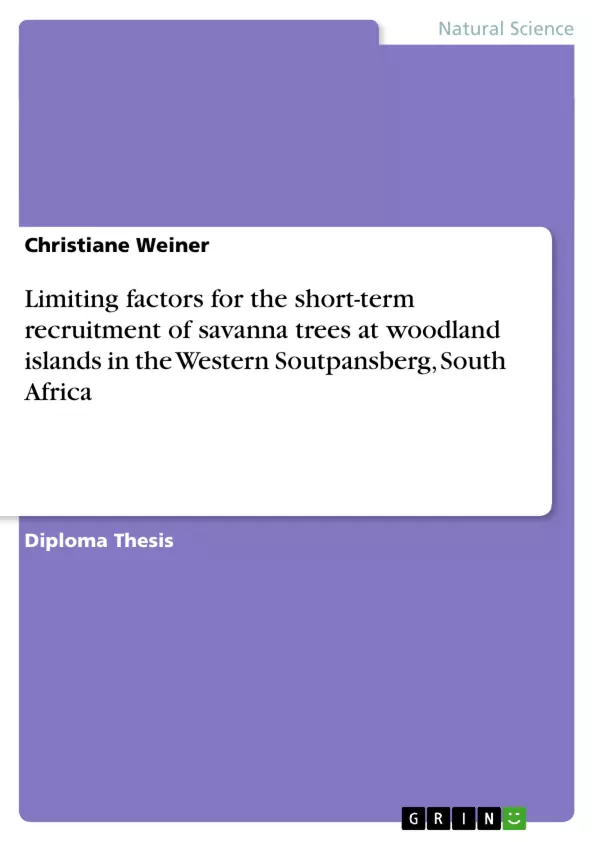A key question of plant ecology is which factors control the local distribution of plant species and plant communities. Thus the appearance of scattered tree dominated fertile patches in generally nutrient-poor savanna grassland is an interesting phenomenon. As trees alter structural and spatial variability of the environment they increase floral and faunal diversity. Under favourable conditions such patches may increase in size until they merge with each other and a closed canopy forest builds up. However, in dry areas successive invasion into grassland is blocked and there is little spread outwards.
Research was conducted from September 2005 to January 2006 in the Western Soutpansberg, South Africa. For Mimusops zeyheri and Syzygium legatii effects of shade and seed size on germination and seedling recruitment have been investigated in plant pot experiments. Two field experiments were conducted investigating seed predation and the effect of competition. Additionally, recruitment was studied at eight tree islands and soil samples from 96 plots varying in exposition, habitat type and location of sampling site were analysed.
Results revealed that tree recruitment was influenced by complex interactions between facilitation and competition, herbivory and abiotic environmental stress. Soil moisture availability, browsing and competition with grasses seem to be the primary factors limiting a rapid expansion of the tree islands into the surrounding grassland. Seed predation slightly reduces seed availability but is not limiting recruitment. Large-seeded seedlings had a higher chance of establishment.
Key words: tree recruitment, islands of fertility, savanna, gradients, competition, Soutpansberg
Inhaltsverzeichnis (Table of Contents)
- I. Introduction
- 1.1 Theoretical background
- 1.1.1 Classification of savanna types
- 1.1.2 Termites
- 1.1.3 Competition and facilitation
- 1.1.4 Fire
- 1.1.5 Browsing and seed predation
- 1.1.6 Life history traits
- 1.2 Research questions
- 1.1 Theoretical background
- II. Methods
- 2.1 Site description: Lajuma and the Western Soutpansberg
- 2.2 Selection of study areas
- 2.3 Tree species
- 2.4 Seed collection and seed weight classes
- 2.5 Experimental set-up
- 2.6 Giving-up density
- 2.7 Soil sampling
- 2.8 Soil temperature measurements
- 2.9 Soil analysis
- 2.10 Vegetation mapping
- 2.11 Data evaluation
- III. Results
- 3.1 Seed weight in Mimusops zeyheri and Syzygium legatii
- 3.2 The influence of termite-affected soil on germination and seedling establishment
- 3.3 Field experiment II: Browsing and competition
- 3.4 Plant pot experiment II: The influence of shading
- 3.5 Giving-up density
- 3.6 Soil type, soil temperature, soil moisture content and bulk density
- 3.7 Soil chemistry
- 3.8 Vegetation mapping
- IV. Discussion
- 4.1 Limitations of the study
- 4.2 The influence of seed weight on short-term tree recruitment
- 4.3 The influence of soil characteristics on short-term tree recruitment
- 4.4 The influence of light intensity on short-term tree recruitment
- 4.5 The influence of competition with grasses on short-term tree recruitment
- 4.6 The influence of seed predation, browsing and grazing on short-term tree recruitment
- 4.7 Limiting factors for tree recruitment in the study area
- V. Conclusion
- VI. Outlook
- VII. Acknowledgements
- VIII. Literature
Zielsetzung und Themenschwerpunkte (Objectives and Key Themes)
The main objective of this study was to investigate the factors influencing the short-term recruitment of savanna trees at woodland islands in the Western Soutpansberg, South Africa. The research focused on the impacts of seed size, soil fertility, light availability, competition, and herbivory on the establishment of tree seedlings.
- The role of seed size in seedling establishment and survival under various environmental conditions.
- The influence of soil fertility, particularly nutrient availability and moisture content, on tree recruitment.
- The effects of light intensity on seed germination and seedling performance.
- The impact of competition with grasses on tree seedling emergence, growth, and survival.
- The significance of herbivory, including seed predation and browsing, in limiting tree recruitment.
Zusammenfassung der Kapitel (Chapter Summaries)
The introduction lays out the theoretical background of savanna ecology, discussing various factors that influence tree-grass coexistence, including competition, facilitation, fire, herbivory, and life history traits. It introduces the study area and outlines the research questions.
Chapter II details the methods employed in the study, including site description, selection of study areas, tree species, seed collection, experimental setups (plant pot and field experiments), soil sampling and analysis, and vegetation mapping.
Chapter III presents the results of the experiments and analyses, covering seed weight distribution, germination rates under different conditions, soil characteristics, and seedling distribution and abundance. It also explores correlations between various factors and seedling recruitment.
Chapter IV provides a comprehensive discussion of the results, examining the limitations of the study, the influence of seed weight, soil characteristics, light intensity, competition, and herbivory on tree recruitment. It identifies the main limiting factors for tree recruitment at the woodland islands.
Schlüsselwörter (Keywords)
This study examines the short-term recruitment of savanna trees at woodland islands in the Western Soutpansberg, South Africa. The focus is on factors such as seed size, soil fertility, light availability, competition with grasses, seed predation, and browsing. Key themes include plant facilitation and competition, herbivory, and abiotic environmental stress.
- Quote paper
- Christiane Weiner (Author), 2006, Limiting factors for the short-term recruitment of savanna trees at woodland islands in the Western Soutpansberg, South Africa, Munich, GRIN Verlag, https://www.grin.com/document/84127



